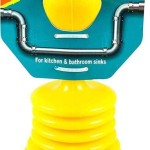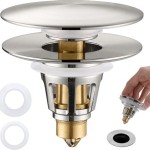Silgranit Sinks: Weighing the Pros and Cons
Silgranit sinks have gained significant popularity in recent years as a modern alternative to traditional stainless steel and cast iron options. These sinks, primarily manufactured by Blanco, a leading kitchen sink manufacturer, are a composite material made from approximately 80% granite stone and 20% acrylic resin. This unique composition gives Silgranit sinks a distinctive look, feel, and set of performance characteristics. Deciding whether a Silgranit sink is the right choice for a kitchen requires a balanced examination of its benefits and drawbacks.
The term "Silgranit" is a proprietary name, and similar composite granite sinks are offered by other manufacturers under different brand names. Regardless of the specific brand, these sinks share similar qualities and should be evaluated using comparable criteria. This article will provide a comprehensive overview of the advantages and disadvantages of Silgranit sinks, enabling consumers to make informed decisions based on their individual needs and preferences.
Durability and Resistance
One of the primary advantages of Silgranit sinks is their exceptional durability. The high granite content makes them incredibly resistant to scratches, chips, and stains. Unlike stainless steel, which is prone to scratching, Silgranit can withstand everyday use without showing significant signs of wear and tear. The acrylic resin component contributes to the sink's overall strength and impact resistance.
Silgranit sinks also exhibit high heat resistance. They can withstand temperatures up to 536°F (280°C) without damage. This is a significant benefit for cooks who frequently handle hot pots and pans directly from the stove or oven. Placing a hot pan directly into a stainless steel sink can potentially discolor or warp the metal, while a Silgranit sink is less susceptible to such issues.
Furthermore, Silgranit sinks are resistant to most household acids and alkalis. This means that spills from common kitchen items like vinegar, lemon juice, or cleaning products are unlikely to cause permanent staining or etching. This resistance contributes to the sink’s longevity and ease of maintenance. However, it's still advisable to clean spills promptly to prevent any potential discoloration over time.
Despite their general durability, Silgranit sinks are not entirely impervious to damage. While scratches are less common than with stainless steel, they can still occur, especially with abrasive cleaning tools or harsh scouring pads. Similarly, while heat resistant, prolonged exposure to extremely high temperatures could potentially cause damage. Therefore, proper care and maintenance are still essential to preserve the sink’s appearance and performance.
Aesthetics and Design
Silgranit sinks offer a wider range of aesthetic options compared to traditional stainless steel sinks. They are available in a variety of colors, from neutral shades like black, gray, and beige to more vibrant hues. This allows homeowners to coordinate the sink with their overall kitchen design and color scheme. The matte finish of Silgranit provides a sophisticated and contemporary look that can enhance the visual appeal of the kitchen.
The color is typically consistent throughout the entire thickness of the sink material, which means that minor scratches are less noticeable than they would be on a surface-coated sink. This consistent color also helps maintain the sink's appearance over time, even with regular use.
Silgranit sinks are manufactured in various shapes and sizes, including single-bowl, double-bowl, and undermount configurations. This variety makes it easier to find a sink that meets specific needs and preferences. Undermount sinks, in particular, create a seamless transition between the countertop and the sink, contributing to a clean and modern design aesthetic.
The textured surface of Silgranit, while contributing to its slip resistance, can also be a point of contention for some users. Some find it more difficult to clean than the smooth surface of stainless steel, as food particles and residue can sometimes get trapped in the texture. However, this can generally be addressed with proper cleaning techniques and the use of appropriate cleaning products.
Maintenance and Cleaning
Maintaining a Silgranit sink is generally straightforward, but it requires a slightly different approach than cleaning a stainless steel sink. The key is to avoid abrasive cleaners and scouring pads, as these can scratch or dull the finish.
For everyday cleaning, warm water and a mild dish soap are usually sufficient. A soft sponge or cloth can be used to wipe down the sink after each use, preventing the buildup of stains and residue. Rinse thoroughly with clean water and dry with a clean cloth to prevent water spots.
For tougher stains or mineral deposits, a specialized granite cleaner or a solution of vinegar and water can be used. It is essential to follow the manufacturer's instructions when using any cleaning product to avoid damaging the sink. Some users find that a paste made from baking soda and water is effective for removing stubborn stains.
One common issue with Silgranit sinks is the potential for white mineral deposits, especially in areas with hard water. These deposits can be removed with a solution of vinegar and water, but it may require repeated applications to fully eliminate them. Regularly drying the sink after use can help prevent the buildup of mineral deposits.
While Silgranit sinks are relatively stain-resistant, certain substances, such as coffee, tea, and red wine, can sometimes cause discoloration if left to sit for extended periods. It is best to clean up such spills promptly to prevent staining. Using a diluted bleach solution on occasion can help remove stubborn stains, but it is important to rinse thoroughly to avoid any lingering residue.
Cost Considerations
Silgranit sinks typically fall into a mid-range price point compared to other types of kitchen sinks. They are generally more expensive than basic stainless steel sinks but less expensive than high-end materials like copper or fireclay. The exact cost depends on the size, shape, color, and features of the sink.
While the initial cost of a Silgranit sink may be higher than that of a stainless steel sink, its durability and longevity can make it a worthwhile investment in the long run. The resistance to scratches, chips, and stains means that it is less likely to need replacement or repair, potentially saving money over time.
Installation costs can vary depending on the complexity of the installation and the plumbing requirements. An undermount sink, for example, may require more precise countertop cutting and installation than a drop-in sink. It is advisable to consult with a professional plumber or contractor to get an accurate estimate of the installation costs.
When comparing the cost of different Silgranit sinks, it is important to consider the warranty offered by the manufacturer. A longer warranty can provide peace of mind and protection against manufacturing defects.
Noise Reduction
Silgranit sinks are known for their superior sound dampening properties compared to stainless steel sinks. The dense composite material absorbs noise, reducing the clanging and echoing sounds that can occur when washing dishes or running water. This is a significant advantage for homeowners who appreciate a quieter kitchen environment.
Stainless steel sinks, especially those made of thinner gauge metal, can amplify the sound of running water and clanging dishes. This can be particularly noticeable in open-concept kitchens where noise travels easily. Silgranit sinks, on the other hand, offer a more muted and dampened sound, contributing to a more peaceful atmosphere.
The noise reduction benefits of Silgranit can be further enhanced by using a sink grid or mat. These accessories provide an additional layer of protection and cushioning, reducing the noise of dishes being dropped into the sink.
While Silgranit sinks are generally quieter than stainless steel sinks, the level of noise reduction can vary depending on the thickness and density of the material. Sinks made with a higher percentage of granite and a thicker construction tend to offer better sound dampening properties.

What To Know Before Investing In Blanco S Silgranit Sink

Blanco Silgranit Ii Granite Composite Kitchen Sink Review

What To Know Before Investing In Blanco S Silgranit Sink

Granite Composite Fireclay Vitreous China And Stainless Steel Sinks In Springfield Mo Wilgusiq

Undermount Sinks Stainless Steel Or Composite Granite

All About Granite Composite Kitchen Sinks

Why I Chose A Blanco Silgranit Sink Southern Hospitality

What Is A Composite Sink Pros Cons Everything Explained

Granite Sinks Everything You Need To Know Qualitybath Com Discover

Thinking About The Blanco Silgranit Sink Pink Little Notebookpink Notebook







